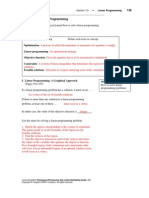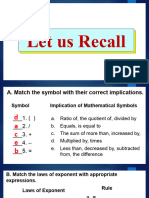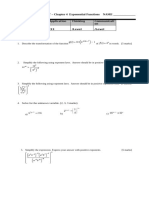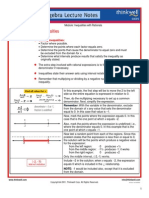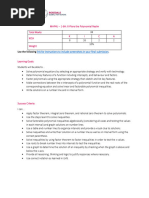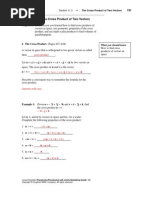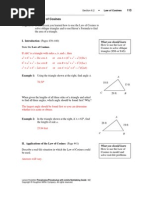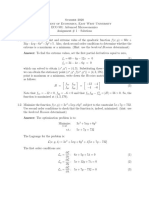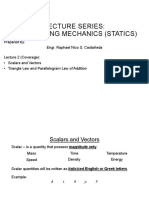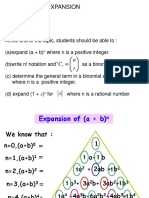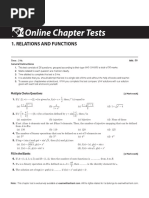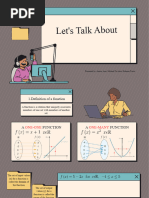Section 2.7 Nonlinear Inequalities: Name
Section 2.7 Nonlinear Inequalities: Name
Uploaded by
sarasmile2009Copyright:
Available Formats
Section 2.7 Nonlinear Inequalities: Name
Section 2.7 Nonlinear Inequalities: Name
Uploaded by
sarasmile2009Original Title
Copyright
Available Formats
Share this document
Did you find this document useful?
Is this content inappropriate?
Copyright:
Available Formats
Section 2.7 Nonlinear Inequalities: Name
Section 2.7 Nonlinear Inequalities: Name
Uploaded by
sarasmile2009Copyright:
Available Formats
Section 2.
7 • Nonlinear Inequalities 53
Name______________________________________________
Section 2.7 Nonlinear Inequalities
Objective: In this lesson you learned how to solve polynomial
inequalities and rational inequalities.
Important Vocabulary Define each term or concept.
Critical numbers The x-values that make the polynomial in a polynomial inequality
equal to zero.
I. Polynomial Inequalities (Pages 197−200) What you should learn
How to solve polynomial
Where can polynomials change signs? inequalities
Only at its zeros, the x-values that make the polynomial equal to
zero.
Between two consecutive zeros, a polynomial must be . . .
entirely positive or entirely negative.
When the real zeros of a polynomial are put in order, they divide
the real number line into . . . intervals in which the
polynomial has no sign changes.
These zeros are the critical numbers of the inequality,
and the resulting intervals are the test intervals t
for the inequality.
Complete the following steps for determining the intervals on
which the values of a polynomial are entirely negative or entirely
positive:
1) Find all real zeros of the polynomial, and arrange the
zeros in increasing order (from smallest to largest).
These zeros are the critical numbers of the polynomial.
2) Use the critical numbers of the polynomial to determine
its test intervals.
3) Choose one representative x-value in each test interval
and evaluate the polynomial at that value. If the value of
the polynomial is negative, the polynomial will have
negative values for every x-value in the interval. If the
value of the polynomial is positive, the polynomial will
have positive values for every x-value in the interval.
Larson/Hostetler Precalculus/Precalculus with Limits Notetaking Guide IAE
Copyright © Houghton Mifflin Company. All rights reserved.
54 Chapter 2 • Polynomial and Rational Functions
To check the solution of the polynomial inequality
3x 2 + 2 x − 5 < 0 with a graph, . . . graph the associated
polynomial equation y = 3x2 + 2x − 5 and locate the portion of the
graph that is below the x-axis.
If a polynomial inequality is not given in general form, you
should begin the solution process by . . . writing the
inequality in general form—with the polynomial on one side and
zero on the other side.
Example 1: Solve x 2 + x − 20 ≥ 0 and graph the solution set.
(− ∞, − 5] ∪ [4, ∞)
−5 0 4
Example 2: Use a graph to solve the polynomial inequality
− x 2 − 6x − 9 > 0 .
∅
y
5
x
-5 -3 -1-1 1 3 5
-3
-5
II. Rational Inequalities (Page 201)
What you should learn
To extend the concepts of critical numbers and test intervals to How to solve rational
inequalities
rational inequalities, use the fact that the value of a rational
expression can change sign only at its zeros and its
undefined values . These two types of numbers
make up the critical numbers of a rational inequality.
Larson/Hostetler Precalculus/Precalculus with Limits Notetaking Guide IAE
Copyright © Houghton Mifflin Company. All rights reserved.
Section 2.7 • Nonlinear Inequalities 55
Name______________________________________________
To solve a rational inequality, . . . first write the rational
inequality in general form. Then find the zeros and undefined
values of the resulting rational expression. Form the appropriate
test intervals and test a point from each interval in the inequality.
Select the test intervals that satisfy the inequality as the solution
set.
3x + 15
Example 3: Solve ≤ 0 and graph the solution set.
x−2
[− 5, 2)
−5 0 2
III. Applications of Other Inequalities (Pages 202−203) What you should learn
How to use inequalities
A formula that relates profit, revenue, and cost is to model and solve real-
Profit = Revenue − Cost . life problems
Example 4: Let the revenue for a product be given by
R = x(30 − 0.005 x) and the cost for the same
product be given by C = 5 x + 20,000 , where R and
C are measured in dollars and x represents the
number of units sold. How many units must be
sold to obtain a positive profit?
1000 < x < 4000
y
12000
11000
10000
9000
8000
7000
6000
5000
4000
3000
2000
1000
0 x
-1000 0 1000 2000 3000 4000 5000 6000
Larson/Hostetler Precalculus/Precalculus with Limits Notetaking Guide IAE
Copyright © Houghton Mifflin Company. All rights reserved.
56 Chapter 2 • Polynomial and Rational Functions
Additional notes
y y y
5 5 5
3 3 3
1 1 1
x x x
-5 -3 -1-1 1 3 5 -5 -3 -1-1 1 3 5 -5 -3 -1-1 1 3 5
-3 -3 -3
-5 -5 -5
Homework Assignment
Page(s)
Exercises
Larson/Hostetler Precalculus/Precalculus with Limits Notetaking Guide IAE
Copyright © Houghton Mifflin Company. All rights reserved.
You might also like
- MYP III Math Summative Aassessment IB Criteria BDocument4 pagesMYP III Math Summative Aassessment IB Criteria BMich Castilleja100% (2)
- Lesson 3 Play It in Reverse Equations UnitDocument16 pagesLesson 3 Play It in Reverse Equations Unitapi-261894355No ratings yet
- Mark Scheme (Results) : Summer 2018Document23 pagesMark Scheme (Results) : Summer 2018XuanyiNo ratings yet
- Unit 1 Linear Programming For CanvasDocument11 pagesUnit 1 Linear Programming For CanvasSayaNo ratings yet
- LAS - Q2 - MATH 7 Week 5Document3 pagesLAS - Q2 - MATH 7 Week 5Marlyn Tenorio100% (1)
- P1 - CH 3 - Equations and InequalitiesDocument78 pagesP1 - CH 3 - Equations and InequalitiesAleena ZahraNo ratings yet
- Section 7.6 Linear Programming: NameDocument2 pagesSection 7.6 Linear Programming: Namesarasmile2009No ratings yet
- CSEC Maths - Crash Course 12 Hour SessionDocument294 pagesCSEC Maths - Crash Course 12 Hour SessionDaiquan StantonNo ratings yet
- Module No. 3: Week 3: First Quarter Simplifying Rational ExpressionsDocument7 pagesModule No. 3: Week 3: First Quarter Simplifying Rational ExpressionsBenazir MotasamNo ratings yet
- Week4 Illustrating and Simplifying Algebraic ExpressionsDocument45 pagesWeek4 Illustrating and Simplifying Algebraic ExpressionsMary Grace TanNo ratings yet
- Lecture 2 Polynomial and Rational Functions 2022 StudentDocument67 pagesLecture 2 Polynomial and Rational Functions 2022 Studentn2yjwgppwbNo ratings yet
- ML Question CMUDocument12 pagesML Question CMUarjbaidNo ratings yet
- Find Rational Zeros: For Your NotebookDocument7 pagesFind Rational Zeros: For Your Notebook미나No ratings yet
- Introduction To Functions: Chapter Test 2Document7 pagesIntroduction To Functions: Chapter Test 2mbaldacchino60No ratings yet
- G8_Q4Document30 pagesG8_Q4jerome.macapagalNo ratings yet
- CH03 895267Document50 pagesCH03 895267Pablo GomezNo ratings yet
- Chapter3 Annotated AlmostwholethingDocument26 pagesChapter3 Annotated Almostwholething蕾酱爱No ratings yet
- Rational Equations and InequalitiesDocument28 pagesRational Equations and InequalitiesAna Marie ValenzuelaNo ratings yet
- Exponents and Radicals: ModuleDocument37 pagesExponents and Radicals: ModuleSaurabh SurvaseNo ratings yet
- An Equilateral Triangle - Has Three Equal Sides and All Angles EqualDocument55 pagesAn Equilateral Triangle - Has Three Equal Sides and All Angles EqualDaniel DadaNo ratings yet
- Modeling QuadraticsDocument7 pagesModeling QuadraticsSarah FathyNo ratings yet
- 4.2 StatDocument4 pages4.2 StatrockytokidealsNo ratings yet
- Lesson 2 Rational Functions, Equations and InequalitiesDocument8 pagesLesson 2 Rational Functions, Equations and InequalitiesCindy BononoNo ratings yet
- Pec104 Homework4Document4 pagesPec104 Homework4qxz92cdyjbNo ratings yet
- cs229 Notes4 PDFDocument11 pagescs229 Notes4 PDFRaja SunkaraNo ratings yet
- June 2015 (IAL) QP - S2 EdexcelDocument12 pagesJune 2015 (IAL) QP - S2 EdexcelnookonooraanNo ratings yet
- Grade - 8 - Maths - Worksheet - Term 3 PDFDocument65 pagesGrade - 8 - Maths - Worksheet - Term 3 PDFDheeraj Yadav100% (1)
- CHPT 4 Test Apr 10Document3 pagesCHPT 4 Test Apr 10Christopher Pasqualini - David Suzuki SS (2662)No ratings yet
- CH3 - Polynomial EquationsDocument15 pagesCH3 - Polynomial Equationsmalik4164512095No ratings yet
- L3_LQE Tables _ ModelsDocument5 pagesL3_LQE Tables _ ModelsMarkisky VinzouteNo ratings yet
- CHAPTER 2 - Lesson 3Document19 pagesCHAPTER 2 - Lesson 3Meljoy TenorioNo ratings yet
- Final 2015 WDocument4 pagesFinal 2015 WViệt NguyễnNo ratings yet
- DM515 - Introduction To Linear and Integer Programming: Sheet 4, Spring 2010Document5 pagesDM515 - Introduction To Linear and Integer Programming: Sheet 4, Spring 2010Gustavo G Borzellino CNo ratings yet
- Module 2-Lesson 3Document10 pagesModule 2-Lesson 3Cindy Bonono100% (1)
- NA_U4M09L02 (1)Document14 pagesNA_U4M09L02 (1)ahamtini163No ratings yet
- 2 Rae Las Q2act2Document2 pages2 Rae Las Q2act2raguindinangel1No ratings yet
- 02 02 QuantilesDocument53 pages02 02 QuantilesMiguel JuniorNo ratings yet
- Math Polinomal EcuationsDocument7 pagesMath Polinomal EcuationsDianaBarriereNo ratings yet
- GennnmsyjDocument21 pagesGennnmsyjmaine cuteeNo ratings yet
- Linear Vs Exponential-1-5Document5 pagesLinear Vs Exponential-1-5Lds EngineersNo ratings yet
- Business Mathematics 1Document17 pagesBusiness Mathematics 1Catherine CambayaNo ratings yet
- Lecture #2: Prediction, K-Nearest Neighbors: CS 109A, STAT 121A, AC 209A: Data ScienceDocument28 pagesLecture #2: Prediction, K-Nearest Neighbors: CS 109A, STAT 121A, AC 209A: Data ScienceLeonardo Lujan GonzalezNo ratings yet
- Lesson Plan in Statistics and ProbabilityDocument2 pagesLesson Plan in Statistics and Probabilitynovellie gantalaNo ratings yet
- 2017 A Level 9758 H2 Math Paper 1 Solution and Paper 2 Likely QuestionsDocument20 pages2017 A Level 9758 H2 Math Paper 1 Solution and Paper 2 Likely QuestionsKeiran Tan100% (1)
- PC11 - CH 07Document78 pagesPC11 - CH 07hanna.nazari11No ratings yet
- Section 4.2 Complex Solutions of Equations: Precisely N Real or Complex and May Be RepeatedDocument3 pagesSection 4.2 Complex Solutions of Equations: Precisely N Real or Complex and May Be RepeatedAlexander Rodriguez AnguloNo ratings yet
- 7.4 Subchapter NotesDocument3 pages7.4 Subchapter NotesMe, Myself and INo ratings yet
- Section 7.1 Linear and Nonlinear Systems of EquationsDocument4 pagesSection 7.1 Linear and Nonlinear Systems of Equationssarasmile2009No ratings yet
- 1-6H X-Plore The Polymomial RealmDocument6 pages1-6H X-Plore The Polymomial Realmyao fengNo ratings yet
- Exponential Functions Performance TaskDocument5 pagesExponential Functions Performance Taskzarebahar_709603175No ratings yet
- Redesigned SAT Math Strategy PacketDocument14 pagesRedesigned SAT Math Strategy PacketTulsi ShahNo ratings yet
- Rational Equations and InequalitiesDocument28 pagesRational Equations and InequalitiesGladys Degones Guiller100% (1)
- Document 5Document13 pagesDocument 5Sid Bets AnderNo ratings yet
- June 2017 (IAL) MS - F3 EdexcelDocument21 pagesJune 2017 (IAL) MS - F3 Edexcelkito030130No ratings yet
- 3 2Document4 pages3 2sarasmile2009No ratings yet
- Chapter4 Test Apr 10 2014Document3 pagesChapter4 Test Apr 10 2014Christopher Pasqualini - David Suzuki SS (2662)No ratings yet
- Week 4 Math Mis G8Document18 pagesWeek 4 Math Mis G8Joseff Rey PizonNo ratings yet
- 22 23+Unit+3+Notes+Packet+ +Topics+1 3+NOTES+KEY (1)Document5 pages22 23+Unit+3+Notes+Packet+ +Topics+1 3+NOTES+KEY (1)kodeeswaransanjhayNo ratings yet
- Let's Practise: Maths Workbook Coursebook 7From EverandLet's Practise: Maths Workbook Coursebook 7No ratings yet
- Section 12.4 Limits at Infinity and Limits of Sequences: NameDocument2 pagesSection 12.4 Limits at Infinity and Limits of Sequences: Namesarasmile2009No ratings yet
- Section 12.5 The Area Problem: NameDocument2 pagesSection 12.5 The Area Problem: Namesarasmile2009No ratings yet
- Analytic Geometry in Three Dimensions: Section 11.1 The Three-Dimensional Coordinate SystemDocument2 pagesAnalytic Geometry in Three Dimensions: Section 11.1 The Three-Dimensional Coordinate Systemsarasmile2009100% (1)
- Section 11.2 Vectors in Space: NameDocument2 pagesSection 11.2 Vectors in Space: Namesarasmile2009No ratings yet
- Section 12.3 The Tangent Line Problem: NameDocument2 pagesSection 12.3 The Tangent Line Problem: Namesarasmile2009No ratings yet
- Section 10.8 Graphs of Polar Equations: NameDocument2 pagesSection 10.8 Graphs of Polar Equations: Namesarasmile2009No ratings yet
- Section 11.3 The Cross Product of Two Vectors: NameDocument2 pagesSection 11.3 The Cross Product of Two Vectors: Namesarasmile2009No ratings yet
- Section 10.9 Polar Equations of Conics: NameDocument2 pagesSection 10.9 Polar Equations of Conics: Namesarasmile2009No ratings yet
- Section 10.6 Parametric Equations: NameDocument2 pagesSection 10.6 Parametric Equations: Namesarasmile2009No ratings yet
- Section 9.6 Counting Principles: NameDocument2 pagesSection 9.6 Counting Principles: Namesarasmile2009No ratings yet
- Section 10.5 Rotation of Conics: NameDocument2 pagesSection 10.5 Rotation of Conics: Namesarasmile2009No ratings yet
- Section 10.3 Ellipses: NameDocument2 pagesSection 10.3 Ellipses: Namesarasmile2009No ratings yet
- Section 9.5 The Binomial Theorem: NameDocument2 pagesSection 9.5 The Binomial Theorem: Namesarasmile2009No ratings yet
- Section 8.3 The Inverse of A Square Matrix: NameDocument2 pagesSection 8.3 The Inverse of A Square Matrix: Namesarasmile2009No ratings yet
- Section 8.4 The Determinant of A Square Matrix: NameDocument2 pagesSection 8.4 The Determinant of A Square Matrix: Namesarasmile2009No ratings yet
- Section 6.2 Law of Cosines: NameDocument2 pagesSection 6.2 Law of Cosines: Namesarasmile2009No ratings yet
- Section 5.5 Multiple-Angle and Product-to-Sum Formulas: NameDocument4 pagesSection 5.5 Multiple-Angle and Product-to-Sum Formulas: Namesarasmile2009No ratings yet
- Section 6.4 Vectors and Dot Products: NameDocument2 pagesSection 6.4 Vectors and Dot Products: Namesarasmile2009No ratings yet
- Section 5.4 Sum and Difference Formulas: NameDocument2 pagesSection 5.4 Sum and Difference Formulas: Namesarasmile2009No ratings yet
- Section 5.2 Verifying Trigonometric Identities: NameDocument2 pagesSection 5.2 Verifying Trigonometric Identities: Namesarasmile2009No ratings yet
- Analytic Trigonometry: Section 5.1 Using Fundamental IdentitiesDocument2 pagesAnalytic Trigonometry: Section 5.1 Using Fundamental Identitiessarasmile2009No ratings yet
- Section 4.8 Applications and Models: NameDocument2 pagesSection 4.8 Applications and Models: Namesarasmile2009No ratings yet
- Eco501 Assignment1 Solutions Summer2020Document3 pagesEco501 Assignment1 Solutions Summer2020maruf91100% (1)
- KPK 10th Maths ch06 KM PDFDocument16 pagesKPK 10th Maths ch06 KM PDFmehreen arshad100% (1)
- On A Class of Bicomplex SequencesDocument14 pagesOn A Class of Bicomplex SequencesMamta Amol WaghNo ratings yet
- Harold Erbin - Notes PDFDocument274 pagesHarold Erbin - Notes PDFSeyf KaddachiNo ratings yet
- Lecture 2Document18 pagesLecture 2Pranjal GuptaNo ratings yet
- Chapter 67 The T = Tan Θ/2 Substitution: EXERCISE 274 Page 750Document7 pagesChapter 67 The T = Tan Θ/2 Substitution: EXERCISE 274 Page 750Carl Joseph MoredoNo ratings yet
- Lecture 2 - Scalars and Vectors Vector Addition Using Triangle Law and Parallelogram Law For AdditionDocument18 pagesLecture 2 - Scalars and Vectors Vector Addition Using Triangle Law and Parallelogram Law For AdditionNasrullah AwalNo ratings yet
- Symmetric Presentations Representations and Related TopicsDocument200 pagesSymmetric Presentations Representations and Related TopicsCrystelGraceAntonioWallNo ratings yet
- 2015 Optimization in Practice With MATLAB For Engineering Students and Professionals PDFDocument11 pages2015 Optimization in Practice With MATLAB For Engineering Students and Professionals PDFHeri Rustamaji100% (1)
- 05 Factors of PolynomialsDocument13 pages05 Factors of PolynomialsEmrah ozkanNo ratings yet
- Direction CosinesDocument25 pagesDirection CosinesJuan Muñoz SaldañaNo ratings yet
- Complex Analytic FunctionsDocument8 pagesComplex Analytic FunctionsMelindaNo ratings yet
- HDHDHDDocument56 pagesHDHDHDHello100% (2)
- Linear Inequalities: Chapter - 6Document4 pagesLinear Inequalities: Chapter - 6pragnya kulkarniNo ratings yet
- What We Know and What We Do Not Know - TuranDocument27 pagesWhat We Know and What We Do Not Know - TuranClaudioNo ratings yet
- Optimal Sizing of Capacitors Placed On A Radial Distribution SystemDocument9 pagesOptimal Sizing of Capacitors Placed On A Radial Distribution SystemghotourNo ratings yet
- Lec 1Document4 pagesLec 1Atom CarbonNo ratings yet
- 8free Fall MotionDocument35 pages8free Fall Motionpak yopNo ratings yet
- Final Review 2024Document16 pagesFinal Review 2024lxbloc.iugc.comsNo ratings yet
- Online Chapter Tests: 1. Relations and FunctionsDocument3 pagesOnline Chapter Tests: 1. Relations and FunctionsExtra WorkNo ratings yet
- FunctionsDocument22 pagesFunctionsМишээл ЯдамсүрэнNo ratings yet
- RappelDocument18 pagesRappelpersonneatchoumNo ratings yet
- Midterm Exam Math in The Modern WorldDocument2 pagesMidterm Exam Math in The Modern WorldJoana Marie Deontoy100% (1)
- 3.1 Image and Kernal of A Linear Trans-Formation Definition. ImageDocument14 pages3.1 Image and Kernal of A Linear Trans-Formation Definition. ImageBrian HaraNo ratings yet
- Problems Using ScilabDocument28 pagesProblems Using Scilabdeepika snehiNo ratings yet
- Derivation Tapered Beam Stiffnss MatrixDocument4 pagesDerivation Tapered Beam Stiffnss MatrixPavan KishoreNo ratings yet
- Full download Lecture Notes on Complex Analysis Ivan Francis Wilde pdf docxDocument81 pagesFull download Lecture Notes on Complex Analysis Ivan Francis Wilde pdf docxsashaeblinc7100% (3)
- 4.4.4 Kelvin's Minimum Energy Theorem: 4.5 Flow Past An ObstacleDocument1 page4.4.4 Kelvin's Minimum Energy Theorem: 4.5 Flow Past An Obstacle224883061No ratings yet
- Lecture 3: Tensor Analysis: Rules For Tensor ManipulationDocument10 pagesLecture 3: Tensor Analysis: Rules For Tensor ManipulationkhayatNo ratings yet
- Statistics and Numerical Methods: Question Ii November / December 2010Document18 pagesStatistics and Numerical Methods: Question Ii November / December 2010Mesiya AnastasiabarusNo ratings yet






